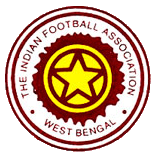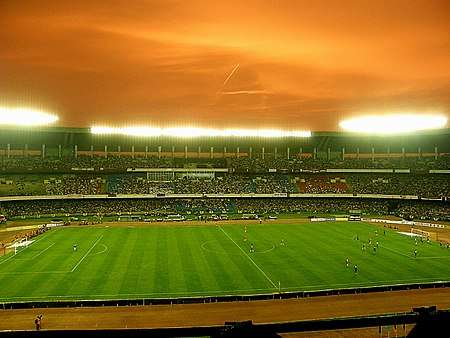West Bengal football team
 | |
| Full name | Bengal Football Team |
|---|---|
| Founded | 1893 |
| Ground |
Howrah Stadium Mohun Bagan Ground Rabindra Sarobar |
| Owner | Indian Football Association |
| Coach | Ranjan Chowdhury[1] |
| League | Santosh Trophy |
The Bengal football team (Bengali: পশ্চিমবঙ্গ ফুটবল টীম) is an Indian football team representing West Bengal in the Santosh Trophy.
They have appeared in the Santosh Trophy finals 43 times, and have won the trophy 31 times,[2] (the most by any team). Prior to 1972, the team competed as 'Bengal'.
Team squad
The following 20 players were called up prior to the 2018 Santosh Trophy[3] Note: Flags indicate national team as defined under FIFA eligibility rules. Players may hold more than one non-FIFA nationality.
|
|
Team officials
Governing Body
- President: Subrata Dutta
- Vice-President: Ajit Bannerjee
- Vice-President: Satadal Gupta
- Vice-President: Debashish Bannerjee
- Hony. Secretary: Utpal Kumar Ganguli
- Hony.Treasurer: Krishnendu Bannerjee
- Hony.Jt.Asst. Secretary: Biswajit Guha Roy
- Hony.Jt.Asst. Secretary: Rabi Routh
- Hony.Jt.Asst. Secretary: Amal Raha
- Hony.Jt.Asst. Secretary: Pranab Bhattyacharya
Honours
Winners: 32
1941–42, 1945–46, 1945–46, 1949–50, 1950–51, 1951–52, 1953–54, 1955–56, 1958–59, 1959–60, 1962–63, 1969–70, 1971–72, 1972–73, 1975–76, 1976–77, 1977–78, 1978–79, 1979–80, 1981–82, 1982–83 (Shared with Goa), 1986–87, 1988–89, 1993–94, 1994–95, 1995–96, 1996–97, 1997–98, 1998–99, 2010–11, 2011–12, 2016–17
Runners-up: 13
1944–45, 1946–47, 1946–47, 1960–61, 1964–65, 1965–66, 1967–68, 1968–69, 1974–75, 1985–86, 2006–07, 2008–09, 2017–18
Grounds
The League and Tournaments are generally played at the following Stadiums and Grounds:saniul
- Asia's biggest composite stadium with capacity of around 1,20,000 with Flood Light.
- Important matches of Local League, Shield, I-League and International Matches are played here.
- Vidyasagar Krirangan, Barasat – Adjacent to Kolkata
- Capacity around 20,000 and Flood Light
- Matches of Local League, Shield are played here. It is also used for holding I-League matches also.
- Present capacity is only around 10,000. But ground condition is extremely good.
- Some important CFL matches and IFA Shield are played here.
- Rabindra Sarobar Stadium Rabindra Sarobar Stadium, Kolkata
- Capacity around 22,000.
- Important League & Shield matches are played here.
- Three enclosed Grounds. Known as East Bengal/Aryan, Mohun Bagan/CFC and Mohammedan/Howrah Union Ground.
- Full capacity of these ground are 23,500, 22,000 and 15,000 respectively. Mohun Bagan/CFC Ground has floodlight facilities.
- Most of the League Matches of Premier League and First Division are played here. But these grounds are available for Football only during the period from 16 May to 10 January every year.
- 10 Open Grounds in the Maidan.
- Only matches of Junior Division and other ordinary competitions are played here. These grounds are available for football only during the period from 16 May to 30 September every year.
- Besides the above-mentioned grounds and stadium, infrastructure of SAI i.e. Sports Authority of India , Kishore Bharati Krirangan are also used.
- Grounds available at various places in Kolkata and Howrah are used for conducting Nursery League Matches. Besides above, small stadiums are also available in almost all the Districts towns and some Sub Divisions. Most important and mentionable stadium is at Siliguri – Kanchenjunga Stadium, where International Tournament like Jawaharlal Nehru Cup was also played. Khardah, Kalyani, Burdwan, Durgapur, Midnapur, Haldia, Malda, Raigunje, Balurghat and a few other District Towns also have Stadium.
- Indoor Stadium
- Netaji Indoor Stadium (AC), Kolkata- Capacity 12,000.
- This Indoor Stadium can be utilized for FUTSAL Competitions.
Salt Lake Stadium
 Salt Lake Stadium | |
| Location | Kolkata, West Bengal, India |
|---|---|
| Owner | Government of West Bengal |
| Capacity | 120,000 |
| Field size | 105 × 68 metres |
| Surface | Astroturf |
| Opened | 1984 |
| Tenants | |
|
West Bengal Football Team (1984–present) Kingfisher East Bengal FC (1984–present) Mohun Bagan AC (1984–present) Prayag United S.C. (2008–present) Mohammedan Sporting (1984–present) | |
Yuva Bharati Krirangan (in Bengali যুবভারতী ক্রীড়াঙ্গন, Yuva Bharati Krirangan or Stadium of the Indian Youth), commonly known as Salt Lake Stadium, is a multi-purpose stadium in Bidhannagar, Kolkata, West Bengal. The stadium is the second largest non-auto racing stadium in the world and the largest in the Indian sub-continent. It is currently used for football matches and athletics. The stadium was built in 1984 and holds 120,000[4] people in a three-tier configuration.
It is situated approximately 10 km to the east of the Kolkata downtown and is elliptical in shape. The roof is made of metal tubes and aluminium sheets and concrete. There are two electronic score boards and control rooms. The lighting is uniformly distributed to facilitate nocturnal sports. There are special arrangements for TV broadcasting.
The stadium covers an area of 76.40 acres (309,200 m2). It was inaugurated in January 1984. The salient features of the stadium are unique synthetic track for athletic meets, electronic scoreboard, main football arena measuring 105m x 70m, elevators, VIP enclosures, peripheral floodlighting arrangement from the roof-top, air conditioned VIP rest room and Conference Hall. Other features of the stadium are also commentary boxes for All India Radio and TV along with several platforms for TV cameras, press boxes, dormitories and AC. rooms, player's changing rooms, practice grounds for football, cricket and khokho, volleyball field and an ultra-medium gymnasium. The stadium has its own water arrangements and standby diesel generation sets.
The floodlights which illuminate the stadium consist of 624 bulbs of 2 kW each and two electronic scoreboards consisting of 36,000 bulbs of 25 watt each. The four underground reservoirs have unique fire-fighting arrangements with a capacity of 10,000 gallons. The architectural and structural design of the stadium was the work of the Joint Consultants viz., M/S. Ballardie, Thompson & Matthews Pvt. Ltd. and M/S. H.K. Sen & Associates – both from Kolkata, West Bengal. The track was prepared by Reckortan Tartan Track, Germany. The electronic scoreboards were supplied by Electro Impex of Hungary.
After its inauguration in January 1984 with the Jawaharlal Nehru International Gold Cup Soccer Tournament, the Salt Lake Stadium has hosted several important international tournaments or matches such as The Pre-World Cup Tournament in 1985, Super-Soccers in 1986, 1989, 1991 and 1994, 3rd S.A.F. games in 1987, U.S.S.R. Festival in 1988, Charminar Challenger Trophy in 1992, Jawaharlal Nehru International Gold Cup in 1995. The chief engineer of the stadium is Somnath Ghosh.
The stadium also hosts different kinds of cultural programs such as dance and music concerts.
Sponsors
| Sponsor type | Sponsor's name |
|---|---|
| Sponsor | Shelly's |
| Co-Sponsor | |
| Kit Sponsor | Cosco |
References
- ↑ "Bengal coach Ranjan Chowdhury not happy with Santosh Trophy preparation". Hindustan Times. 17 March 2018.
- ↑ "Another Santosh feather in Bengal's cap". The All India Football Federation. 9 July 2011.
- ↑ "Santosh Trophy 2018: Bengal look to defend their title, announce 20-man squad". Sportskeeda. 18 March 2018.
- ↑ East Bengal Football Club